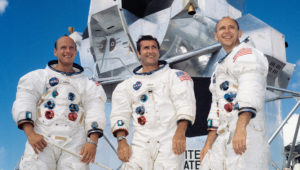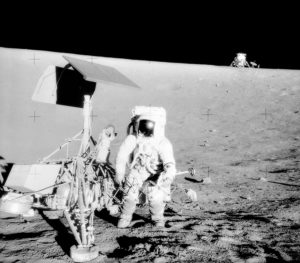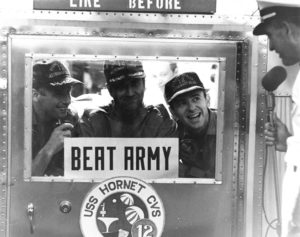The first lunar landing flight—Apollo 11—was a momentous achievement in the history of humanity. Astronauts Armstrong, Aldrin, and Collins will forever be remembered for their courage and tenacity in executing this historic event. Apollo 11 was a serious and focused mission, fulfilling President Kennedy’s challenge to land a man on the moon during the 1960s.
However, my favorite lunar landing was the second one—Apollo 12—performed just four months after the first. The flight crew was an “All Navy” team, the only Apollo mission whose members were from the same branch of the military. Charles “Pete” Conrad was the Mission Commander, Richard “Dick” Gordon was the Command Module Pilot and Alan Bean was the Lunar Module Pilot. All of them had been naval aviators and test pilots before they joined NASA with a honed sense of accomplishing risky missions. They had a high level of comradery and trust in each other well before being assigned as the Apollo 12 flight team.
Their personalities, however, helped make the Apollo 12 flight significantly different than Apollo 11. Of course, as test pilots, they shared a common acceptance of taking risks and making lightening quick, but calculated, decisions.
But Pete had an irrepressible sense of humor and a passion for flying anything he could get into. Dick enjoyed living life to the fullest extent possible with a motto of “work hard, play hard.” Alan was the cerebral one, with a scientific mindset. His intimate technical knowledge of the Apollo Command Module saved the mission after it was struck by lightning upon liftoff from Kennedy Space Center. But he also had an artistic flair, with an eye for inspired composition.
The Apollo 11 mission was simple–find any acceptable level spot on the moon and park on it. The Apollo 12 flight plan, however, called for trying to make a pin-point landing near an unmanned American reconnaissance spacecraft called Surveyor 3, which had landed in the Ocean of Storms two years earlier.
After three days and 250,000 miles of travel, the Lunar Module (LM) detached from the Command Module in orbit around the moon. Pete and Alan began their decent to the lunar surface. Despite the fact he’d never before flown this spacecraft, Pete flew it by hand rather than by computer and landed only 600 feet from Surveyor 3! Just as a good naval aviator would hit the “3 wire” when making a landing on aircraft carrier in the Pacific Ocean. Fly Navy!
On November 19, 1969, Pete and Alan became the third and fourth humans to walk on the moon. Pete’s most famously remembered comment occurred when he descended the LM ladder onto the moon. The last step was a tall one (roughly 3 feet) and Pete was only 5’6” in height. After jumping down onto the foot of the lander, Pete exclaimed, “Whoopee! That may have been a small one for Neil, but that’s a long one for me!” The rest of their two moon walks included dancing, jokes, and laughs, and humming a tune while plucking the camera off the Surveyor to bring back to earth.
Upon their return to earth, they splashed down in the Pacific Ocean, narrowly missing their recovery ship, the aircraft carrier USS Hornet (CVS-12). NASA folks were glad the Apollo command module was not equipped with a tail hook, or Pete would have tried to catch that 3 wire!
The hijinks continued, even though they were world heroes. The annual Army-Navy college football game was held a few days after their return. The astronauts proclaimed their bias by writing a sign and holding it up to the back window of the moon germ quarantine trailer onboard the Hornet.
For me, what was special about the Apollo 12 team was their humanness. They weren’t robots or rocket scientists; just everyday people (well, with the “right stuff” of course). They worked hard at their jobs and accomplished their missions as a team. But then they enjoyed life too. This group gave generations of youngsters hope that they too might go into space someday.
Alan Bean became a highly acclaimed space artist. Pete Conrad and Dick Gordon both worked to help open up space travel by privatizing it. They laid the ground work for space exploration companies like Virgin Galactic and SpaceX.
Pete died in 1999, while driving a motorcycle thru southern California near Ojai (a perfect ending for an “always on the go” type of guy, if there ever is such a thing). Dick Gordon passed away in November of 2017, just months after his loving wife died. Alan Bean left us just a few weeks ago, during Memorial Day weekend.
In 2004, Alan was the featured speaker at the Hornet Museum commemoration of the 35th anniversary of the Apollo 11 and 12 flights. While waiting to introduce him, we chatted for a while. I asked him what he now thought about having walked on the moon. He immediately answered, “The worst day on earth is better than the best day on the moon. There is no atmosphere, no wind, no trees, no plants, no living creatures, and no water. Like Antarctica, it’s a nice place to visit, but you wouldn’t want to live there.”
Food for thought while we consider ideas and plans about the colonization of the moon or Mars!
As the flight crew of Apollo 12 soars into the heavens for eternity, we wish you “fair winds and following seas.”
Leave a Reply